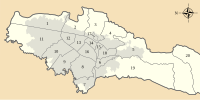Santa Fe, Bogotá
This article needs additional citations for verification. (May 2007) |

Santa Fe is the third locality of Bogotá, Capital District of Colombia. Santa Fe is the traditional downtown of the city of Bogotá. This area once comprised Bogotá's total main urban area and was known as "Santa Fe de Bogotá" with its traditional neighborhoods.
Santa Fe is one of Bogotá's most developed areas and includes the area by the Carrera Septima, one of the main arteries with most of Bogotá's skyscrapers. The International Center and the financial district of the Avenida Jimenez are also located within Santa Fe. It also contains the colonial-era commercial neighborhood of San Victorino.
The main streets of Bogotá intersect in Santa Fe: the "Carrera Septima" (7th Avenue) formerly known as Calle Real (Royal Street), the "Carrera Decima" (10th Avenue), "Calle 26" (26th Street), the "Circunvalar Avenue", "Caracas Avenue", "Ciudad de Lima Avenue" and "Jimenez Avenue".
Santa Fe also has a rural area which covers the mountains of Monserrate and Guadalupe. The locality of La Candelaria was the foundation site of Bogotá and is enclaved in the middle of Santa Fe. La Candelaria was separated from Santa Fe after the creation of the Capital District.
History

Bogotá was founded by Gonzalo Jiménez de Quesada in 1538 under the name of Santa Fe. The legal foundation occurred at the Bolívar Square in La Candelaria between the rivers of San Francisco (now Jimenez avenue) and San Agustin (now 6th Street).
During the early years of the 20th century, the city was confined within the present territory of Santa Fe until the 1920s when urbanization expanded towards Chapinero and later towards the west in the 1950s just before the violent days of El Bogotazo that partially destroyed the streets.
Santa Fe got a minor city hall in 1972. With the Constitutional reform of 1991, Santa Fe legally became a locality (or a Local Action Junta) of the Capital District.
General Data

- Population: 107,044 people (1993 census)
- Average temperature: 13 °C
- Total area: 4,487.74 ha
- Urban area: 662.05 ha
To the north, Santa Fe is bordered by the Canal Arzobispo or "Calle 39" (39th Street), bordering the locality of Chapinero. To the south it is bordered by Avenida Primera, con San Cristóbal. In the east, it is bordered by the Cerros Orientales (eastern mountains, bordering with the municipalities of Choachí and Ubaque in Cundinamarca Department. Lastly, the city is bordered in the west by Avenida Caracas, with Teusaquillo, Los Mártires and Antonio Nariño.
Among the neighborhoods there are Las Cruces, Los Laches, La Perseverancia, La Concordia, Santa Inés, Santa Bárbara, San Bernardo, La Merced, Egipto, Germania, Las Aguas, La Paz, La Peña, Liévano, Las Nieves, El Consuelo, Belén, Egipto Alto, Central, El Rocío, Tisquesuza, La Macarena and El Bosque Izquierdo. Veredas are Monserrate and El Vergel mountains.
Santa Fe is crossed by the San Francisco River, San Agustín River, Arzobispo River and San Cristóbal River. Because of its proximity to the eastern mountains, the urban area near these mountains is tilted some 40 degrees.
Economy
Santa Fe is mostly a commercial area with some small factories and service companies such as financial businesses, hotels and tourism facilities. There are some important universities in the area such as University of the Andes, Universidad Externado de Colombia, Jorge Tadeo Lozano University among others.
Transport
TransMilenio operates in the Avenida Caracas and Avenida Jiménez de Quesada. A funicular and an aerial tramway to climb Monserrate have existed since 1926.
Sites of interest

- Colombian National Museum
- Independence Park, Tercer Milenio Park and the Olaya Herrera National Park
- La Santamaría Bullring (opening its season in February)
- La Rebeca
- The Natural History Museum
- The Planetarium
- The Gold Museum
- The National Library of Colombia
- The churches of San Francisco, la Tercera, la Veracruz and la Capuchina
- Las Cruces Marketplace
- Colpatria Tower


